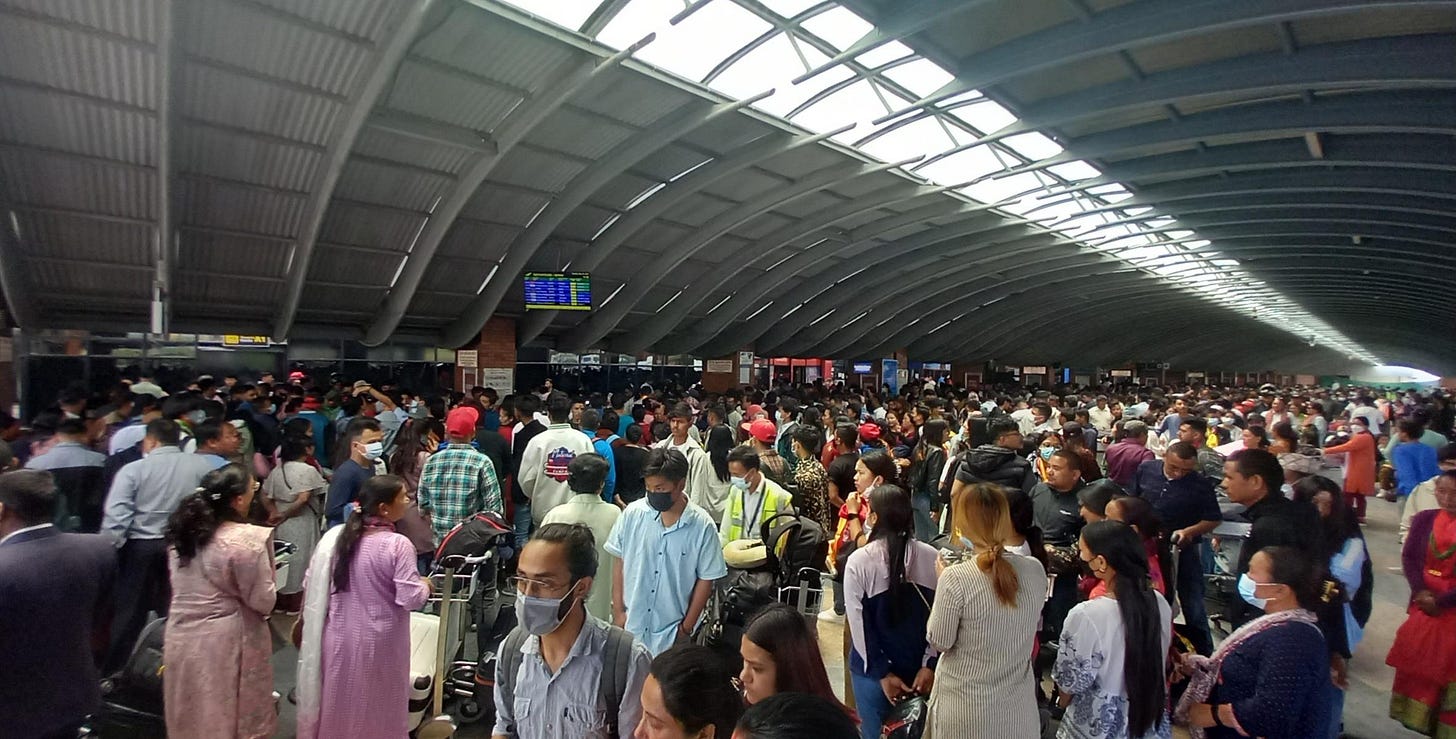Misunderstood Migration
Migration is not the problem; our inability to harness it is.
Views expressed here are personal, based on notes and self-reflection following the event “Academic Discourse on Migration and Development: Economic Opportunities and Challenges of Migration for Nepal.” organized by Nepal government, International Organization Migration, Tribhuvan University, and Kathmandu University on 29th January 2025
Nepali newspapers greet us every morning with photos of crowded airports, tearful farewells, and headlines tallying the number of citizens boarding flights abroad. Social media amplifies this narrative, glamorous snapshots of migrants posing in foreign cities, juxtaposed with cynical memes mocking those “left behind.” We have collectively branded migration as a national shame: a “brain drain” crippling Nepal, while those who remain are dismissed as unskilled or unambitious. But this reductive framing ignores history, economics, and Nepal’s own policy failures. Migration is not the problem; our inability to harness it is.
Migration: A Scapegoat for Systemic Failures
Migration is as old as human civilization. People have been moving across borders whether temporary or permanent, voluntary or forced. Herders move seasonally for pastures, people in the mountains to escape freezing temperatures, students migrate for education, laborers seek better wages, and families relocate for safety. Nepal’s history is shaped by mobility: Newar traders crossing Himalayan passes into Tibet, Gurkhas serving global armies, some as Bahadurs in India and generations of youth leaving villages for Kathmandu’s promise of opportunity. Yet today, we treat migration as a pathology rather than a natural response to inequality.
The real issue lies not in people leaving, but in why they feel compelled to. Nepal’s cities, overcrowded, polluted, and staggeringly expensive, are monuments to failed planning. Rural municipalities, stripped of basic infrastructure, schools, and hospitals, hemorrhage talent. Our policies oscillate between romanticizing agrarian life and tacitly endorsing labor export as an economic strategy. Migration is not the crisis; it is a symptom of a deeper rot.
Internal Migration: A Tale of Mismanaged Potential
The 2021 Census reveals that 29% of Nepalis migrate internally, primarily to Kathmandu and Biratnagar. These cities, once symbols of progress, now suffocate under unplanned growth. Kathmandu’s drainage systems collapse under monsoon rain. The promotion of private motorbikes and vehicles to fuel import taxes for revenue generation discouraged public transportation, leading to hours of traffic jams. The lack of jobs and underpaid labor struggle to retain workers. Urbanization, if managed wisely, could drive economic growth. Instead, we have allowed our cities to become pressure cookers of frustration. We have incentivized urbanization without preparing for it, then blame migrants for the mess.
Out-Migration: The Remittance Trap
Remittances, contributing 25% of Nepal’s GDP, are celebrated as an economic lifeline. Yet this dependence masks a grim reality: our youth are not migrating out of ambition, but desperation. Nepal’s transition from an agrarian to a service-based economy failed to generate jobs. Instead of building factories or tech hubs, we opened service industry, exploited lands as real estate cash cows, and created a speculative bubble that benefits elites.
Migrants send billions home, but these funds flow into real estate and consumption, not productivity. A nurse in Australia earning AUD 30/hour remits money to build a concrete house in Makwanpur, which stands empty while her village lacks a clinic. Meanwhile, Nepal’s diaspora, a potential force for trade and investment, remains untapped. Returned migrants bring skills in construction, departmental stores, engineering, healthcare, and IT, but find no ecosystem to deploy them. We lament “brain drain” while wasting “brain gain.”
Breaking the Cycle: A Path Forward
1. Decentralize Development
Empower Nepal’s 753 local governments to build self-sustaining economies. Why must a student from Palpa migrate to Kathmandu for college? Invest in regional universities, rural hospitals, and agro-industries in the Tarai. Redirect internal migration to emerging hubs like Jumla or Dipayal to shorten its distance.
2. Allow Hassle-Free Foreign Direct Investment
Prioritize FDI by lowering the current threshold, allowing 100% ownership in priority sectors, and amending forex laws to let investors withdraw profits without hurdles. It is time for Nepal to tap into the markets available beyond its borders, in two highly populous nations.
3. Transform Remittances into Productivity
Create tax incentives for migrants to invest in renewable energy, agro-processing, or tech startups, not land hoarding. Establish a “Diaspora Skill Bank” to connect returnees with local industries.
4. Stop Blaming, Start Planning
Nepal cannot simultaneously fetishize migration as “success” and vilify it as “betrayal.” Formalize labor migration with skill-building programs and social security. Partner with destination countries for reintegration programs.
5. Improve Implementation Efficiency
Policies gets diluted when it comes to execution. Nepal should invest in efforts to bring all the bureaucrats at all levels together in order to ensure consistency and effectiveness.
Conclusion: Rewriting the Narrative
Migration is not Nepal’s curse; it is a mirror reflecting decades of policy indifference. The exodus will continue until we offer citizens a reason to stay. Imagine a Nepal where villages have schools as good as Kathmandu’s, where returned migrants launch startups in Surkhet, and where laborers abroad are upskilled into ambassadors for Nepali innovation.
This future is possible. But first, we must stop scapegoating migrants and confront the real enemy: our refusal to build a nation worth staying for.



Same piece was earlier submitted and published in The Annapurna Express.. I just found out that they had it published.. so here's the link from the newspaper https://theannapurnaexpress.com/story/52703/